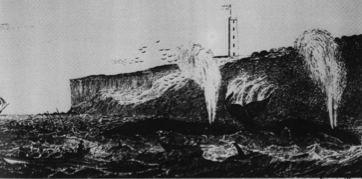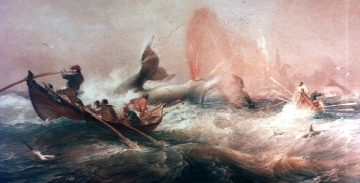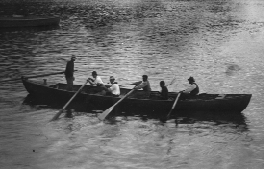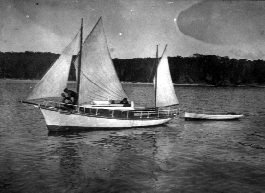

History
For an unknown number of generations, the Yuin people of twofold bay benefitted
from the natural hunting strategies of the local Killer whales. The various
tribes who inhabited the bay integrated the orcas into their belief systems as
the orcas would regularly herd migrating baleen whales into the bay and the
whales would commonly strand themselves on beaches to escape the killers. As a
result, the yuin people believed that the orcas were deliberately provding food
for the tribes and that the killers were the re-incarnated spirits of tribal
members. Early european explorers documented rituals where the yuins would “call” the orcas to drive whales to shore. Whale oil played a part in tribal rituals
up and down the east coast and the yuins had a fascinating use for a rotting
carcase. They would climb naked into the rotting flesh and remain encased for
hours with only their head protruding. The heat of decomposition and putrid
smelling oils were claimed to cure rheumatism and other maladies.
The first european whaler in Twofold Bay was Thomas Raine in 1828, followed by
the Imlay Brothers in the 1830s. The Imlays employed a number of yuin people
and discovered that they were hard working, reliable, talented fellows with
excellent eyesight and boat-handling skills.
In the 1840s, Scottish entrepeneur Benjamin Boyd set up a new town known as Boyd
Town which he hoped to one day rival Sydney or Melbourne. He spared no expense
importing Sydney sandstone for his lighthouse on south head and constructed
Inns and churches, housing and store rooms, wharves and stock-yards. (Boyd’s story is covered in detail by Tom Mead’s book “Empire of Straw”).
A fair quantity of construction in Boydtown was carried out by carpenter
Alexander Walker Davidson, a recent emigree from Scotland.
Boyd aquired a number of Steamships to ply the east coast and set up whaling
stations in Sydney harbour and Twofold Bay.
Overseeing the Twofold Bay operation was Oswald Brierly who left detailed
written accounts and paintings and sketches of activities. Competition in the
bay for whales was so tough that Boyd took to offshore whaling for sperm whale
far out past the continental shelf.
Brierly’s diaries of the shore based whaling in the 1840s indicate that the killers were
involved but a number of crews were reluctant to share any catch with the
killers and would attack them with sharp boat-spades, oars etc to drive them
away. One crew had set out to catch an enormous killer with a dorsal fin
reportedly 8 foot tall, the biggest anyone had seen. Obviously, any crew that
did not regularly attack the killers would begin to acquire preferential
treatment from the pod.
After a few years, Boyd’s empire collapsed and much of the bay whaling gear was purchased by Alexander
W. Davidson and business partner and store owner Solomon Solomon.


An etching by Sir Oswald Brierly of a whale chase beneath Boyd’s Tower, with killer whales in attendance. This image from the 1840s parallels
the still from the 1910 movie and therefore pictorially documents at least 70
years of Killer whale participation in the Eden whaling industry.


“The Death Flurry” by Sir Oswald Brierly, painted in the 1840s of a whalehunt in Twofold bay with
stylised small killers in attendance.
The unfortunate right whale is in its last moments, with its blowhole spouting
blood.


Alexander and his son John Simpson Davidson began whaling from their 5 and 7
oared boats, and with their carpentry skills, could maintain and repair their
green painted boats easily.
Strict presbyterians and tea totalling lay preachers, the Davidsons believed in
treating all people fairly and would pay their indiginous crews equally well as
the whites. The acceptable term at the time for a fully paid, all indiginous
crew was a “full darky crew”.
This engendered much loyalty and the Davidsons absorbed some of the reverence of
the killers, affirming the “law of the tongue” and winning the loyalty of the killers too.
The numerous members of the Davidson clan would partipipate in whaling as well
as their cousins the Greig family.
Competition crews included the Walker bros, George Barclay, the Widow Barclay, the Rixons, John Boyd, the Powers, the
Whelands, the Newlands and various others from time to time.
However the killers favoured the Davidsons and to compensate, the other crews
adopted technologies such as explosive “bomb guns” that only served to annoy the killers and make them even less likely to assist
anyone other than the Davidsons.
Eventually the Davidsons had the assistance of the killers all to themselves.
Alexander’s grandson George Davidson was born in Eden in May 1863 and began whaling by the
age of 14. By the 1890s he became the master whaler and took over the family
business. The whaling was a difficult business financially and the Davidsons
largely supported themselves from their vegetable gardens, chicken runs,
fishing and livestock.
George was known as Fearless George and had escaped death and drowning many
times. He had swum with the killer Tom on a number of occasions.
Over time, the number of killers dwindled untill the 1920s when rarely more than
3 were spotted.
The Davidsons had been told that Norwegians operating in Australian waters had
shot a lot of them.
Tom died and floated into the bay on Sept 13 1930, effectively signaling the end
of bay whaling from rowing boats in NSW.
For decades elsewhere in the world, whaling had been conducted using vast
steamships and canon fired harpoons whilst the Davidsons had used hand thrown
harpoons and rowing boats. During the 20th century, the Davidsons were
conducting an archaic, obsolete enterprise yet as a result, their overheads
were low, their catches were low and their impact on whale numbers far less
than operations using more sophisticated technology.

A typical Davidson 5 oared whaling boat.
George Davidson at steer oar (sweep) with 3 members of aboriginal Thomas family
at front of boat.
Eden whalers never hunted from motorboats.


J.R Logan’s launch the “white heather”, which was often requested to be used as a rescue boat in the 1920s and to tow
whales home. It was involved in an altercation with Tom which possibly led to
the loss of a tooth and subsequent possibly fatal infection. Logan’s daughter Margaret Brooks was present on the yacht on the occasion and held
onto the rear mast as Tom used his bulk to sink the stern of the boat. The
white Heather is believed to still exist on the brisbane river in Queensland












